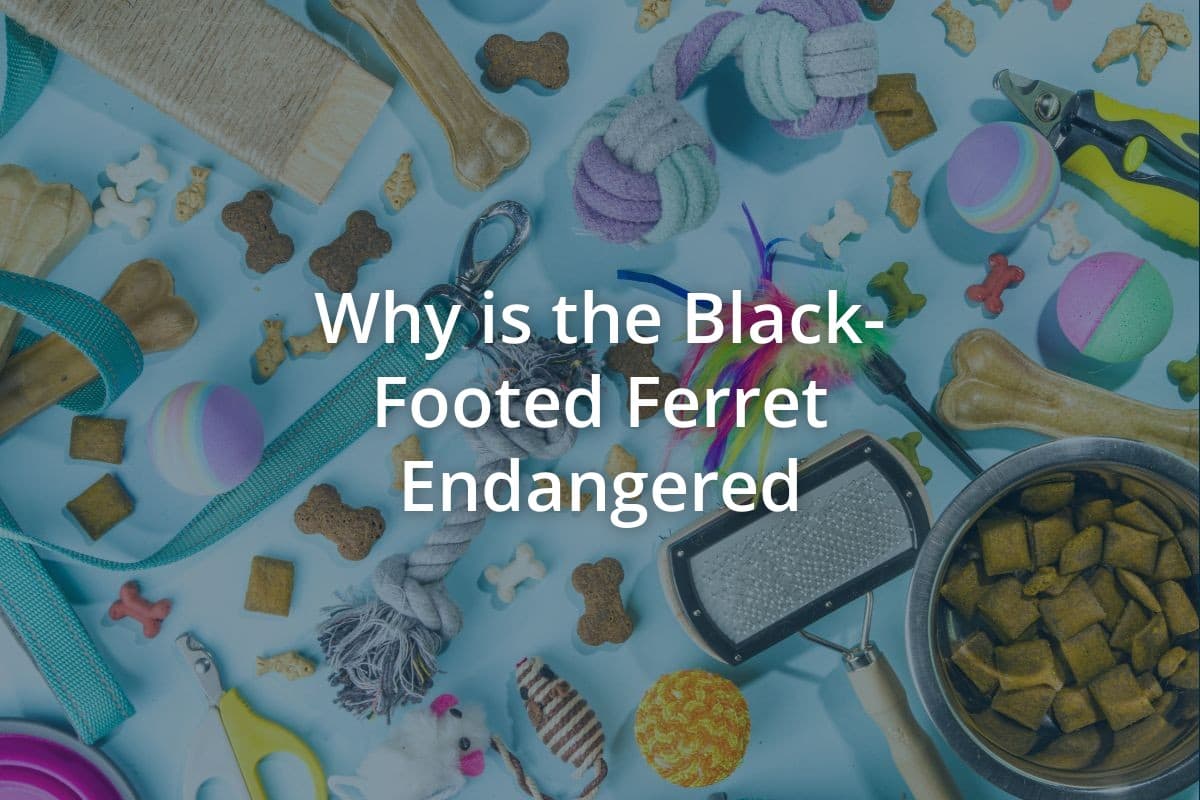Do you ever wonder why the black-footed ferret is endangered? It’s a result of several factors.
Habitat loss, caused by human activities, has greatly impacted their survival. Prey scarcity and disease outbreaks have further worsened their situation. Additionally, competition with other species for resources has put them at a disadvantage.
The genetic bottleneck they face limits their ability to adapt and survive in changing environments. Climate change poses additional challenges, while illegal wildlife trade threatens their existence. Sadly, inadequate conservation efforts have failed to reverse this alarming trend.
Let’s delve into the reasons why the black-footed ferret is facing such dire circumstances.
Habitat Loss
You need to understand that habitat loss is one of the main reasons why black footed ferrets are endangered. Human interference and habitat fragmentation have played a significant role in reducing their population and pushing them towards extinction.
Habitat loss occurs when natural habitats, such as grasslands or prairies, are destroyed or altered by human activities. These activities include agriculture, urbanization, and industrial development. As a result, the black footed ferret’s habitat has been greatly reduced over the years.
Human interference not only destroys the physical environment but also disrupts the delicate balance of ecosystems. When humans encroach upon these habitats, they bring with them various disturbances like noise pollution, introduction of invasive species, and alteration of natural vegetation patterns. These disturbances further exacerbate the challenges faced by black footed ferrets.
Habitat fragmentation is another consequence of human activities that directly impacts black footed ferrets. It occurs when large areas of continuous habitat are divided into smaller patches due to roads, fences, or other barriers. This fragmentation isolates populations and restricts their movement, making it harder for them to find mates and resources essential for survival.
Prey Scarcity
Finding enough food is challenging for them due to a scarcity of prey. The black-footed ferret, an endangered species, relies heavily on specific prey items such as prairie dogs and ground squirrels for its survival. However, the decline in prey populations has resulted in a significant decrease in available food sources for these ferrets.
- Prey Decline: Over the years, human activities such as habitat destruction and disease control measures have led to a decline in prairie dog and ground squirrel populations. This reduction in prey availability directly affects the black-footed ferret’s ability to find sufficient food.
- Food Scarcity: As a result of the declining prey populations, black-footed ferrets have to cover larger areas in search of food. Their limited energy reserves make it crucial for them to efficiently locate suitable prey within their range. However, due to the scarcity of food, they often struggle to meet their nutritional needs.
- Competition with other predators: The decreasing availability of prey also intensifies competition between black-footed ferrets and other predators that rely on similar resources. This competition further exacerbates the challenge faced by these already endangered animals.
Understanding the impact of prey scarcity on black-footed ferrets is vital for conservation efforts aimed at preserving this species. Efforts should be made towards conserving both their habitat and increasing the availability of suitable prey, ensuring their survival in the wild.
Disease Outbreaks
In this discussion, you’ll explore the impact of disease outbreaks on the population of black-footed ferrets. The focus will be on understanding how these outbreaks affect their numbers and overall survival.
You’ll also examine disease prevention strategies implemented to mitigate the spread of pathogens among these endangered species.
Impact on Population
The black-footed ferret’s population has been significantly impacted due to habitat loss and disease. Conservation efforts have been implemented to mitigate these impacts and ensure the survival of this endangered species.
- Habitat Loss: The conversion of grassland habitats into agricultural land and urban development has resulted in the destruction of the black-footed ferret’s natural habitat. This loss of suitable living space has led to a decline in their population.
- Disease Outbreaks: Black-footed ferrets are highly susceptible to diseases such as canine distemper and sylvatic plague, which can decimate their populations. These outbreaks have further contributed to the decline in their numbers.
- Conservation Efforts: Various organizations and government agencies are actively involved in conservation efforts for the black-footed ferret. These initiatives include captive breeding programs, reintroduction projects, monitoring population trends, and implementing vaccination campaigns against diseases. The aim of these initiatives is to stabilize and increase the black-footed ferret population by addressing both habitat loss and disease threats.
Disease Prevention Strategies
To prevent disease outbreaks, you should ensure that the black-footed ferret population receives regular vaccinations and implement effective quarantine measures. Vaccines play a crucial role in protecting animals from infectious diseases and are an essential tool in wildlife management. Vaccine development for black-footed ferrets has been a focus of research to safeguard their vulnerable population. By vaccinating these endangered species, we can reduce the risk of disease transmission and improve their chances of survival. Additionally, implementing quarantine measures can help limit the spread of pathogens within populations and minimize the impact of infectious diseases on black-footed ferret communities. These strategies are vital for maintaining healthy populations and preserving this critically endangered species.
| Disease | Vaccination Schedule | Quarantine Measures |
|---|---|---|
| Distemper | Annually | Isolate infected individuals |
| Plague | Biannually | Monitor wild rodent populations |
| Rabies | Every 3 years | Restrict contact with potentially infected animals |
| Canine Parvovirus | Annually | Maintain clean environments |
Implementing these disease prevention strategies is critical in conserving the black-footed ferret population and ensuring their long-term survival.
Long-Term Conservation Measures
Implementing long-term conservation measures is essential for the survival and protection of black-footed ferrets. To ensure their continued existence, it is imperative to focus on conservation strategies and restoration efforts.
Here are three key aspects to consider:
- Habitat preservation: Protecting and restoring suitable habitats is crucial for black-footed ferret populations. This involves identifying and conserving areas that offer adequate resources such as prey species and burrow systems.
- Genetic diversity management: Maintaining genetic variation is vital for the long-term viability of any species. Implementing breeding programs that prioritize genetic diversity can help prevent inbreeding depression and enhance overall population health.
- Collaboration among stakeholders: Successful conservation requires collaboration between government agencies, landowners, scientists, and other stakeholders. By working together, we can develop comprehensive strategies that address habitat loss, disease control, captive breeding programs, and public awareness initiatives.
Competition With Other Species
Black-footed ferrets face intense competition with other species in their habitat, which contributes to their endangerment. Competition dynamics and predation effects play a significant role in shaping the population dynamics of black-footed ferrets.
Competition for resources such as food, water, and shelter is a common occurrence among species sharing the same environment. Black-footed ferrets compete with other small carnivores like coyotes and badgers for prey items such as prairie dogs, which are their primary source of food. As a result of this competition, black-footed ferrets often struggle to find enough food to sustain themselves and reproduce successfully.
In addition to competition for resources, predation also poses a threat to black-footed ferret populations. They are susceptible to predation by larger predators such as golden eagles, bobcats, and great horned owls. These predators can significantly reduce the number of available individuals within the population.
Furthermore, diseases transmitted by other species also contribute to the endangerment of black-footed ferrets. For example, sylvatic plague carried by fleas affects both prairie dogs and black-footed ferrets alike, leading to widespread mortality.
Understanding the complex interaction between competition dynamics and predation effects is crucial for developing effective conservation strategies for the endangered black-footed ferret populations. By managing these factors appropriately, we can help mitigate threats faced by these fascinating creatures and work towards ensuring their long-term survival in the wild.
Genetic Bottleneck
When it comes to the genetic bottleneck of black-footed ferrets, you need to understand the limited genetic diversity within their population.
Due to a small founder population, these ferrets have been subject to inbreeding, resulting in increased rates of infertility and reduced fitness.
This lack of genetic variation also makes them highly vulnerable to diseases and other environmental pressures.
Limited Genetic Diversity
The limited genetic diversity of the black-footed ferret population poses a significant threat to their long-term survival. Due to a historical bottleneck event, the population has experienced a severe reduction in its gene pool, resulting in decreased genetic adaptation and evolutionary potential. This lack of diversity hampers the ability of the black-footed ferrets to adapt to changing environments and increases their vulnerability to diseases and other threats.
Reduced Genetic Variation: The limited number of individuals carrying different alleles restricts the capacity for natural selection and evolution.
Inbreeding Depression: Mating between closely related individuals leads to an increased risk of harmful genetic mutations and decreased fitness.
Susceptibility to Disease: With reduced genetic diversity, black-footed ferrets are more susceptible to infectious diseases that can spread rapidly within a small gene pool.
To ensure the long-term survival of this endangered species, efforts must be made to enhance genetic diversity through captive breeding programs and reintroduction strategies. By expanding the gene pool, we can increase their chances of adapting and evolving in response to environmental changes, ultimately securing their future.
Inbreeding and Infertility
Inbreeding, a consequence of limited genetic diversity in the black-footed ferret population, has led to various reproductive issues, including infertility. When individuals with closely related genetic backgrounds mate, harmful recessive traits become more prevalent in their offspring. This increased frequency of deleterious genes can result in reduced fertility and lower survival rates among the ferrets.
To address this issue, genetic rescue options have been explored. One approach is introducing individuals from different populations into the breeding program to increase gene flow and diversify the genetic pool. This helps counteract the negative effects of inbreeding by introducing new variations that may enhance reproductive success.
Additionally, assisted reproductive technologies such as artificial insemination and embryo transfer are being utilized to overcome fertility challenges caused by inbreeding. These techniques allow for controlled breeding between genetically diverse individuals, increasing the chances of producing healthy offspring.
Vulnerability to Diseases
Due to limited genetic diversity, black-footed ferrets are susceptible to diseases. This lack of genetic variation weakens their immune system, making them more vulnerable to disease transmission. The low number of individuals in the population increases the chances of disease outbreaks spreading rapidly and causing devastating effects.
- Reduced resistance: The black-footed ferret’s compromised immune system makes it difficult for them to fight off infections and diseases.
- Increased susceptibility: With a limited gene pool, these animals lack the necessary genetic variations that allow for a strong immune response against pathogens.
- High mortality rates: Disease outbreaks can have a catastrophic impact on black-footed ferret populations, leading to significant declines or even extinction.
It is crucial to address the issue of limited genetic diversity in order to enhance the overall health and resilience of black-footed ferret populations. Efforts should focus on promoting genetic mixing among individuals across different populations through conservation breeding programs and habitat management strategies.
Climate Change
Climate change is causing significant challenges for the black-footed ferret population. As a result of rising temperatures and altered precipitation patterns, their habitats are undergoing drastic changes, making it difficult for these endangered creatures to adapt. The black-footed ferret is highly specialized and depends on prairie dog colonies for food and shelter. However, climate change has led to the decline of prairie dog populations, resulting in a loss of suitable habitat for the ferrets.
To address this issue, climate adaptation strategies are being implemented to help the black-footed ferret survive in changing environments. These strategies involve identifying potential areas where the ferrets could relocate or establishing wildlife corridors that connect fragmented habitats. By providing access to different areas with suitable conditions, these adaptation measures aim to increase the resilience of the black-footed ferret population.
In addition to climate adaptation efforts, habitat restoration plays a crucial role in ensuring the survival of black-footed ferrets. Restoration initiatives focus on restoring degraded grasslands by reintroducing native vegetation and removing invasive species. These actions create a more favorable environment for both prairie dogs and black-footed ferrets.
Overall, addressing the challenges caused by climate change requires a combination of climate adaptation strategies and habitat restoration efforts. By implementing these measures, we can give the threatened black-footed ferret population a fighting chance against extinction in an increasingly unpredictable world.
Illegal Wildlife Trade
To combat the illegal wildlife trade, you can support organizations and campaigns that raise awareness about the devastating impacts it has on endangered species. By doing so, you contribute to ongoing conservation efforts aimed at protecting these vulnerable animals.
Here are three ways you can make a difference:
- Donate: Financial contributions to reputable conservation organizations help fund vital initiatives such as anti-poaching patrols, undercover investigations, and legal advocacy.
- Report Suspicious Activity: If you come across any information or witness activities related to the illegal wildlife trade, report them to local law enforcement agencies or wildlife authorities. Your actions could lead to the dismantling of criminal networks involved in this illicit trade.
- Educate Yourself and Others: Stay informed about the issues surrounding the illegal wildlife trade and share your knowledge with friends, family, and colleagues. By raising awareness, you encourage others to join the fight against this destructive practice.
The illegal wildlife trade remains a significant threat to endangered species worldwide. Through collective efforts and support for conservation organizations, we can work towards curbing this illicit activity and ensuring a future where all species thrive in their natural habitats.
Lack of Conservation Efforts
If you want to make a difference in conservation efforts, consider supporting organizations and initiatives that work towards protecting vulnerable species from extinction. Currently, one of the major challenges in conservation is the lack of public awareness and understanding about the importance of preserving biodiversity. Many people are unaware of the threats faced by endangered species such as the black-footed ferret.
One significant factor contributing to their decline is human-wildlife conflict. As human populations continue to expand, there is an increasing overlap between wildlife habitats and human settlements. This leads to conflicts arising from competition for resources or perceived threats to human safety. In the case of the black-footed ferret, they often face persecution due to their predation on prairie dogs, which are considered pests by some landowners.
Addressing these issues requires a multi-faceted approach. It involves educating communities about the ecological role and value of endangered species like the black-footed ferret. By fostering understanding and empathy towards these animals, we can reduce conflicts and promote coexistence. Additionally, raising public awareness through campaigns and outreach programs can garner support for conservation initiatives.
Conclusion
In conclusion, the black-footed ferret is endangered due to a combination of factors. Habitat loss and prey scarcity have significantly impacted their survival. Disease outbreaks and competition with other species have also taken a toll on their population. Additionally, genetic bottlenecking has limited their ability to adapt and thrive in changing environments.
Climate change further exacerbates these issues, making it even more challenging for them to survive. Illegal wildlife trade poses another threat to their conservation efforts.
It is crucial that we increase conservation efforts and address these concerns if we are to prevent the extinction of this remarkable species.




